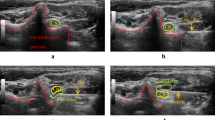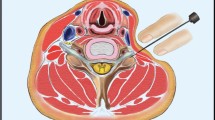Abstract
Several techniques have been described for selective nerve root blocks. We describe a novel ‘two-needle technique’, performed through the postero-lateral route with the patient in lateral position under C-arm guidance. The aim of the current study is to highlight the effectiveness and safety of cervical selective nerve root block for radiculopathy using this technique. We present results of a retrospective 2-year follow-up study of 33 injections carried out on 33 patients with radiculopathy due to cervical disc disease and or foraminal stenosis using this procedure. Patients with myelopathy, gross motor weakness and any other pathology were excluded. The outcome was measured comparing ‘Visual Analogue Score’ (VAS) and ‘Neck Disability Index’ (NDI) before the procedure with those at 6 weeks and 12 months after the procedure. Thirty patients were included in the final analysis. Average pre-operative VAS score was 7.4 (range 5–10), which improved to 2.2 (range 0–7) at 6 weeks and 2.0 (range 0–4) at 1 year and the mean NDI score prior to intervention was 66.9 (range 44–84), which improved to 31.7 (range 18–66) at 6 weeks and 31.1 (range 16–48) at 1 year. The improvements were statistically significant. Patients with involvement of C6 or C7 nerve roots responded slightly better at 6 weeks with regards to VAS improvement. Mean duration of radiation exposure during the procedure was 27.8 s (range 10–90 s). Only minor complications were noted—transient dizziness in two and transient nystagmus in one patient. Our ‘two-needle technique’ is a new, safe and effective non-surgical treatment for cervical radiculopathy.






Similar content being viewed by others
References
Radhakrishnan K, Litchy WJ, O’Fallon WM, Kurland LT (1994) Epidemiology of cervical radiculopathy. A population-based study from Rochester, Minnesota, 1976 through 1990. Brain 117(Pt 2):325–335
Lestini WF, Wiesel SW (1989) The pathogenesis of cervical spondylosis. Clin Orthop Relat Res 69–93
Lees F, Turner JW (1963) Natural history and prognosis of cervical spondylosis. Br Med J 5373:1607–1610
Saal JS, Saal JA, Yurth EF (1996) Nonoperative management of herniated cervical intervertebral disc with radiculopathy. Spine 21:1877–1883
Dillin W, Booth R, Cuckler J, Balderston R, Simeone F, Rothman R (1986) Cervical radiculopathy. A review. Spine 11:988–991
Bush K, Hillier S (1996) Outcome of cervical radiculopathy treated with periradicular/epidural corticosteroid injections: a prospective study with independent clinical review. Eur Spine J 5:319–325
Cyteval C, Thomas E, Decoux E, Sarrabere MP, Cottin A, Blotman F, Taourel P (2004) Cervical radiculopathy: open study on percutaneous periradicular foraminal steroid infiltration performed under CT control in 30 patients. AJNR Am J Neuroradiol 25:441–445
Slipman CW, Lipetz JS, Jackson HB, Rogers DP, Vresilovic EJ (2000) Therapeutic selective nerve root block in the nonsurgical treatment of atraumatic cervical spondylotic radicular pain: a retrospective analysis with independent clinical review. Arch Phys Med Rehabil 81:741–746
Vallee JN, Feydy A, Carlier RY, Mutschler C, Mompoint D, Vallee CA (2001) Chronic cervical radiculopathy: lateral-approach periradicular corticosteroid injection. Radiology 218:886–892
Windsor RE, Storm S, Sugar R, Nagula D (2003) Cervical Transforaminal injection: review of the literature, complications, and a suggested technique. Pain Physician 6:457–465
Chiu TT, Hui-Chan CW, Chein G (2005) A randomized clinical trial of TENS and exercise for patients with chronic neck pain. Clin Rehabil 19:850–860
Giles LG Muller R (2003) Chronic spinal pain: a randomized clinical trial comparing medication, acupuncture, and spinal manipulation. Spine 28:1490–1502
Lafuente J, Casey AT, Petzold A, Brew S (2005) The Bryan cervical disc prosthesis s an alternative to arthrodesis in the treatment of cervical spondylosis: 46 consecutive cases. J Bone Joint Surg Br 87:508–512
Peolsson A, Vavruch L, Oberg B (2006) Predictive factors for arm pain, neck pain, neck specific disability and health after anterior cervical decompression and fusion. Acta Neurochir (Wien) 148:167–173
Boehm H, Greiner-Perth R, El-Saghir H, Allam Y (2003) A new minimally invasive posterior approach for the treatment of cervical radiculopathy and myelopathy: surgical technique and preliminary results. Eur Spine J 12:268–273
Center for Devices and radiological Health, Food and Drug Administration (2000) Guidance document for the preparation of IDEs for spinal systems
Vernon H, Mior S (1991) The neck disability index: a study of reliability and validity. J Manipulative Physiol Ther 14:409–415
Rydevik B, Brown MD, Lundborg G (1984) Pathoanatomy and pathophysiology of nerve root compression. Spine 9:7–15
Lee HM, Weinstein JN, Meller ST, Hayashi N, Spratt KF, Gebhart GF (1998) The role of steroids and their effects on phospholipase A2. An animal model of radiculopathy. Spine 23:1191–1196
Olmarker K, Byrod G, Cornefjord M, Nordborg C, Rydevik B (1994) Effects of methylprednisolone on nucleus pulposus-induced nerve root injury. Spine 19:1803–1808
Johansson A, Hao J, Sjolund B (1990) Local corticosteroid application blocks transmission in normal nociceptive C-fibres. Acta Anaesthesiol Scand 34:335–338
Bush K, Chaudhuri R, Hillier S, Penny J (1997) The pathomorphologic changes that accompany the resolution of cervical radiculopathy. A prospective study with repeat magnetic resonance imaging. Spine 22:183–186
Wagner AL (2005) CT fluoroscopic-guided cervical nerve root blocks. AJNR Am J Neuroradiol 26:43–44
Morvan G, Mompoint D, Bard M (1998) Direct intra-foraminal injection of corticosteroids in the treatment of cervico-brachial pain. In: Bard M, Laredo J (eds) Interventional radiology in bone and joint. Springer, Heidelberg, pp 253–257
Larkin TM, Carragee E, Cohen S (2003) A novel technique for delivery of epidural steroids and diagnosing the level of nerve root pathology. J Spinal Disord Tech 16:186–192
Furman MB, Giovanniello MT, O’Brien EM (2003) Incidence of intravascular penetration in transforaminal cervical epidural steroid injections. Spine 28:21–25
Brouwers PJ, Kottink EJ, Simon MA, Prevo RL (2001) A cervical anterior spinal artery syndrome after diagnostic blockade of the right C6-nerve root. Pain 91:397–399
Ludwig MA, Burns SP (2005) Spinal cord infarction following cervical transforaminal epidural injection: a case report. Spine 30:E266–E268
Ma DJ, Gilula LA, Riew KD (2005) Complications of fluoroscopically guided extraforaminal cervical nerve blocks. An analysis of 1036 injections. J Bone Joint Surg Am 87:1025–1030
Rathmell JP, Aprill C, Bogduk N (2004) Cervical transforaminal injection of steroids. Anesthesiology 100:1595–1600
Acknowledgments
Mr. David Goda, Senior lecturer statistics, University of Wolverhampton for statistical support and help.
Author information
Authors and Affiliations
Corresponding author
Rights and permissions
About this article
Cite this article
Kumar, N., Gowda, V. Cervical foraminal selective nerve root block: a ‘two-needle technique’ with results. Eur Spine J 17, 576–584 (2008). https://doi.org/10.1007/s00586-008-0600-6
Received:
Revised:
Accepted:
Published:
Issue Date:
DOI: https://doi.org/10.1007/s00586-008-0600-6




